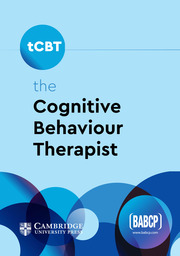No CrossRef data available.
Article contents
Treating trauma-driven OCD with narrative exposure therapy alongside cognitive behavioural therapy
Published online by Cambridge University Press: 06 January 2023
Abstract
When post-traumatic stress disorder (PTSD) co-occurs with obsessive compulsive disorder (OCD), symptoms of the former can interfere with evidence-based treatment of the latter. As a result, exposure-based treatments are recommended for both OCD and PTSD, potentially facilitating a concurrent treatment approach. This case study describes the application of concurrent cognitive behaviour therapy (CBT including exposure and response prevention; ERP) for OCD and narrative exposure therapy to treat a patient whose PTSD symptoms of intrusive images of memories and hyperarousal were interfering with standard CBT (including ERP) treatment for OCD. Following this concurrent approach, the patient’s symptoms of OCD reduced to non-clinical levels and showed reliable improvement in PTSD symptoms. Whilst further methodologically robust research is required, this case study highlights that this approach may be beneficial to the treatment of OCD where PTSD symptoms are impacting on treatment.
-
(1) To explore the literature considering explanations of the co-occurrence of OCD and PTSD symptomology.
-
(2) To consider how symptoms of two mental health conditions can maintain one another and attenuate the effectiveness of evidence-based treatment for the other mental health condition.
-
(3) Consider the use of concurrent therapeutic approaches to treat co-occurring mental health conditions.
- Type
- Case Study
- Information
- Copyright
- © The Author(s), 2023. Published by Cambridge University Press on behalf of the British Association for Behavioural and Cognitive Psychotherapies



Comments
No Comments have been published for this article.